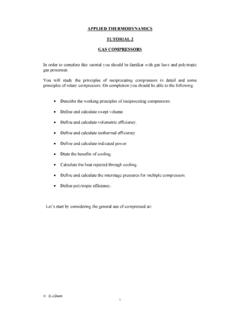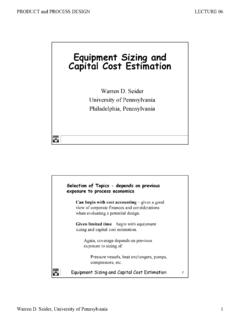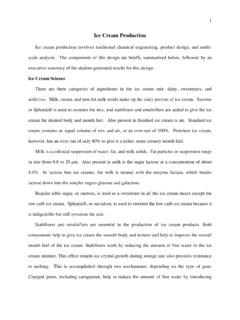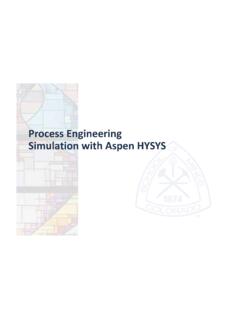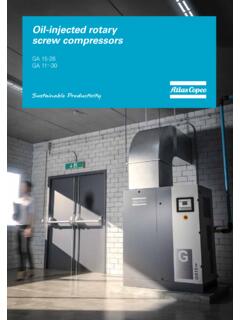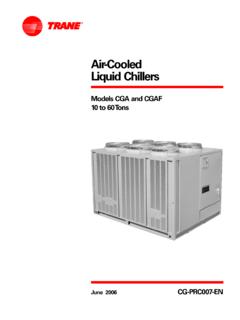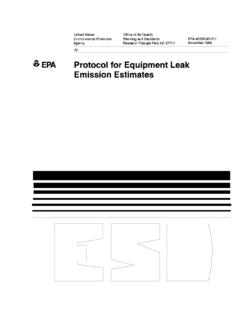Transcription of Hydrogen Station Compression, Storage, and Dispensing ...
1 Hydrogen Station Compression, Storage, and Dispensing Technical Status and Costs Independent Review Published for the Department of Energy Hydrogen and Fuel Cells Program NREL is a national laboratory of the Department of Energy, Office of Energy NREL is a nEfficiency ational laboratory of the & Renewable Department Energy, operated boy f tEhe nergy, Office Alliance for oSf ustainable Energy Energy, LLC. Efficiency & Renewable Energy, operated by the Alliance for Sustainable Energy, LLC. Technical Report NREL/BK-6A10-58564. May 2014. Contract No. DE- AC36- 08GO28308 Hydrogen Station Compression, Storage, and Dispensing Technical Status and Costs G.
2 Parks, R. Boyd, J. Cornish, and R. Remick Independent Peer Review Team NREL Technical Monitor: Neil Popovich NREL is a national laboratory of the Department of Energy, Office of Energy Efficiency & Renewable Energy, operated by the Alliance for Sustainable Energy, LLC. National Renewable Energy Laboratory Technical Report 15013 Denver West Parkway NREL/BK-6A10-58564. Golden, CO 80401 May 2014. 303-275-3000 Contract No. DE- AC36- 08GO28308 NOTICE. This report was prepared as an account of work sponsored by an agency of the United States government. Neither the United States government nor any agency thereof, nor any of their employees, makes any warranty, express or implied, or assumes any legal liability or responsibility for the accuracy, completeness, or usefulness of any information, apparatus, product, or process disclosed, or represents that its use would not infringe privately owned rights.
3 Reference herein to any specific commercial product, process , or service by trade name, trade- mark, manufacturer, or otherwise does not necessarily constitute or imply its endorsement, recommendation, or favoring by the United States government or any agency thereof. The views and opinions of authors expressed herein do not necessarily state or reflect those of the United States government or any agency thereof. Available electronically at Available for a processing fee to Department of Energy and its contractors, in paper, from: Department of Energy Office of Scientific and Technical Information Box 62. Oak Ridge, TN 37831-0062. phone: fax: email: Available for sale to the public, in paper, from: Department of Commerce National Technical Information Service 5285 Port Royal Road Springfield, VA 22161.
4 Phone: fax: email: online ordering: Cover photos (clockwise from top): Production: Photo by Jack Dempsey, NREL 14580; Fuel Cells: Photo by Chris Ainscough, NREL 19512; Manufacturing R&D: Photo by Michael Ulsh, NREL 18309; Technology Validation: Photo by Keith Wipke, NREL 15724; Market Transformation: Photo by Jennifer Kurtz, NREL. 18347; Safety, Codes and Standards: Photo by Leslie Eudy, NREL 10916; Education: Photo by Dennis Schroeder, NREL 20824; Storage: Photo by Pat Corkery, NREL 15759; and Delivery: Photo from Energetics, Inc., NREL 17985. Printed on paper containing at least 50% wastepaper, including 10% post consumer waste. April 22, 2014.
5 From: Independent Review Panel, Hydrogen Station Compression, Storage, and Dispensing Technical Status and Costs To: Neil Popovich, National Renewable Energy Laboratory, Department of Energy Hydrogen Systems Integration Office Subject: Independent Review Panel Summary Report As required by the Department of Energy contract with the Independent Review Panel, these are the panel's unanimous technical conclusions, arrived at from data collection, document reviews, interviews with industry experts, and panel deliberations from November 2012 through March 2014. All reported compression, storage, and Dispensing (CSD) contributions to the cost of Hydrogen dispensed at the forecourt include a real 10% internal rate of return on investments and are expressed in 2007 reference-year dollars (2007$).
6 For the central production pipeline scenario, the Hydrogen is delivered to the refueling Station via pipeline providing an average annual rate of production of 1,000 kg/d. For distributed generation, the Hydrogen is produced by steam reforming of natural gas at the forecourt refueling Station at a design capacity of 1,330. kg/d annual average rate of production. For the tube-trailer scenario, the Hydrogen is delivered as compressed gas at 500 bar via overland tractor trailer to a forecourt refueling Station with a design capacity of 850 kg/d annual average rate of delivery. The central production pipeline and forecourt stations sizes (1,000 kg/d and 1,330 kg/d, respectively) were chosen for this analysis because they reflect the Station sizes modeled in the Department of Energy's publicly available cost-evaluation tools: the H2A Forecourt Hydrogen Production Model (H2A) and the Hydrogen Delivery Scenario Analysis Model (HDSAM).
7 The high-pressure tube-trailer Station size (850 kg/d) evaluated was the result of the Independent Review Panel's cost-optimization analysis. The Independent Review Panel found that for a high-pressure tube-trailer delivery scenario, an 850-kg/d Dispensing Station resulted in the lowest cost of dispensed Hydrogen based on the delivery technologies most likely to be available and thus represented the best approach toward achieving the Department of Energy's 2020 dispensed Hydrogen cost target for centrally produced Hydrogen . The costs reviewed in this report include only those costs contributing to the selling price of Hydrogen by the forecourt CSD portion of the Hydrogen Station and do not include the costs of production or delivery to the Station .
8 Conclusions The current cost of CSD at the forecourt, projected in 2007$ for a mature market (15%. penetration of fuel cell vehicles) ranges from $ of Hydrogen to $ of Hydrogen for the central production case with delivery via pipeline with a base case 1 of ~$ of Hydrogen . The wide variance is a result of uncertainties in the cost and 1. The base case, defined in the Panel Results section of this report, is the cost/value that the Independent Review Panel determined is most likely. iii efficiency of the compressor , the cycle life of the vessels used in the high-pressure cascade system, and the Station installation costs. These costs were evaluated using the Current Hydrogen Delivery Scenario Analysis Model Version (released October 2011).
9 The current cost of CSD at the forecourt, projected in 2007$ for a mature market, ranges from $ to $ of Hydrogen for the forecourt production from natural gas with a base case of ~$ of Hydrogen . Again, uncertainties in compressor costs, efficiency, and installation factors caused a wide variance in projected costs. These costs were evaluated using the H2A Current Forecourt Production from Natural Gas Model Version (released February 2012). The current cost of CSD at the forecourt using high-pressure (500-bar) tube trailers for delivery ranges from $ to $ with a base case of ~$ of Hydrogen . Uncertainties in compressor cost and installation factors are the prime contributors to uncertainty.
10 These costs were evaluated using the Future Hydrogen Delivery Scenario Analysis Model Version (released March 2012) as requested by the project monitor. This work benefitted significantly from the use of Argonne National Laboratory's H2 SCOPE model to size compressor and cascade configuration. (The H2 SCOPE model was developed at Argonne National Laboratory in 2013.). The methodology for calculating CSD costs as embodied in the suite of H2A and HDSAM models is adequate for calculating these costs. However, the Station configuration (storage sizing, compression sizing, and default component costs) in the specific model cases need to be better optimized for 700-bar Dispensing .











